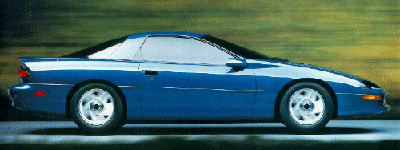New Car Review
1996 CHEVROLET CAMARO V6
by Tom and Bob Hagin

SEE ALSO: Chevrolet Buyer's Guide
SPECIFICATIONS
Manufacturer's Suggested Retail Price $ 14,990
Price As Tested $ 21,334
Engine Type 3.8 Liter V6 w/SFI*
Engine Size 231 cid/3791 cc
Horsepower 200 @ 5200 RPM
Torque (lb-ft) 225 @ 4000 RPM
Wheelbase/Width/Length 101.1"/74.1"/193.2"
Transmission Four-speed automatic
Curb Weight 3298 pounds
Fuel Capacity 15.5 gallons
Tires (F/R) P235/55R16
Brakes (F/R) Disc-ABS/disc-ABS
Drive Train Front-engine/Rear-wheel-drive
Vehicle Type Four-passenger/two-door
Domestic Content 86 percent
Coefficient of Drag (Cd.) N/A
PERFORMANCE
EPA Economy, miles per gallon
city/highway/average 19/29/24
0-60 MPH 8.0 seconds
1/4 mile (E.T.) 16.2 seconds @ 84 mph
Top Speed (Est.) N/A
* Sequential fuel injection
(The Chevrolet Camaro is almost a national institution, having been around for 30 years. The '96 version performs well, even in standard V6 form and Tom Hagin says it's a good compromise to the high profile Z28. Bob agrees, but wishes for more performance options on the test car.
BOB - Just like old times, Tom, driving around in a Camaro. But I imagine that the performance of this new "stocker" version suffers compared to that '70 SS model you had when you were a kid.
TOM - Actually this new base model comes on pretty strong. The standard model Camaro has come a long way in just a few years and it can't be considered just a "wanabee" street racer anymore. Toward the end of its previous body style, Chevy put some pretty anemic engines under its hood and ten years ago they even put little four-banger in it - and what a slug! That car should have been made illegal.
BOB - Well, immoral, anyway. Not all Camaro owners need or even want the big 350-inch LT1 V8 under the hood, but at the same time, the car needs enough power to enter the highway without it being a knuckle- whitening experience. And it would almost be a criminal act if a new Camaro had to crawl up steep grades in the slow lane.
TOM - Which is why the new 3.8 liter V6 used as standard equipment in the '96 model is so desirable. It pumps a healthy 200 horses and 225 lb-ft of torque. With that setup, there's a balance of performance and economy that really shines during the everyday commute, especially with the optional four-speed automatic transmission at $790.
BOB - So there's a new, more powerful V6 under the hood, and the current fourth generation Camaro already handles pretty well, so what else has Chevy done to make the Camaro better than last year's model?
TOM - Well, Dad, for those who want an open-air feeling without a ragtop will enjoy the optional T-Tops that are offered for the first time on the new body style. For $970 extra, drivers can unlatch a lever on each panel and stow both of the inserts in the trunk using a newsystem that stacks the T-Tops neatly in the cargo area. They're held inplace by the same mechanism that attaches them to the roof. And two detachable shades are also offered as a $25 option - that's the way I'd equip a Camaro if I bought one.
BOB - Personally, I prefer a solid top. Anytime a car maker starts chopping sections out of the car's structure, things start tovibrate loose. I'd put it the money into the optional handling package which makes the standard Camaro handle almost like the Z28. The handling of our test car was great, although the solid rear axle made itself apparent on fast, twisting roads when the surface was rough.
TOM - That's true, Dad, but Camaro already comes standard with double wishbone front suspension, with modified geometry that allowed Chevy engineers to use stiffer control arm bushings without compromising the ride. Our tester carried that $400 Performance Handling Package, and it also adds a limited slip rear axle, four-wheel disc brakes, dual exhaust outlets and a quicker steering ratio. To get this package, however, the buyer has to also go for the optional larger (P235/55R16) tires at $132, and alloy wheels for $275.
BOB - Which ends up making the almost-$15,000 Camaro into a $21,000 masterpiece. With all those extras, I'd start looking toward the Z28 version which has a base price of $19,390.
TOM - But Dad, the insurance tab on one of those street racers is out of sight. Insurance companies know the Z28 can attain 150 mph right off the showroom floor and adjust their rates accordingly. The buying of a factory hot-rod is only an initial payment. That's one of the things that makes the standard version of the Camaro so versatile.
BOB - The seats are really comfortable and border on being equal to those expensive aftermarket competition chairs. The quick steering is a bit heavy while parking, but at high speed it smooths out very well. I'd have preferred the standard five-speed transmission, however.
TOM - Dad, the way you talk, maybe it's you older guys who should be stuck with higher insurance rates on sports cars.


